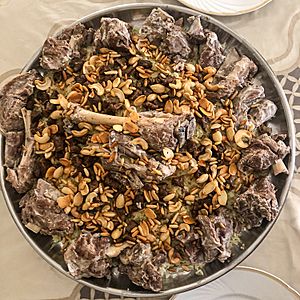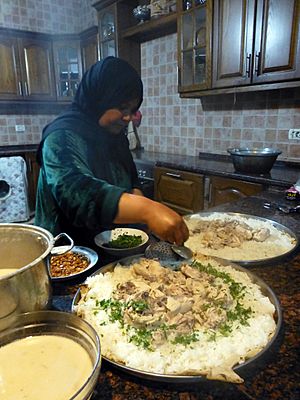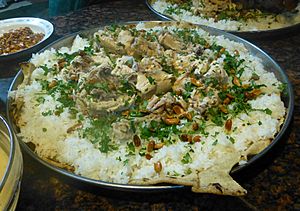Mansaf facts for kids

A variant of mansaf in Amman, Jordan made with samneh(ghee)-infused rice and decorated with sauteed nuts alongside jameed-drenched lamb.
|
|
| Course | Meal |
|---|---|
| Place of origin | Jordan |
| Main ingredients | lamb, jameed, rice or bulgur, shrak bread |
Mansaf (Arabic: منسف) is a very special and traditional dish from Jordan. It's made with lamb meat cooked in a creamy sauce. This sauce is unique because it uses a special kind of dried yogurt called jameed. Mansaf is usually served with rice or bulgur (a type of cracked wheat).
This tasty dish is popular across the Levant region, which includes countries like Jordan, Syria, and parts of Saudi Arabia. It's even considered the national dish of Jordan! The name "Mansaf" means "large tray" or "large dish," which makes sense because it's often served on a big platter for everyone to share. Over the years, the way Mansaf is made has changed quite a bit, especially between the 1940s and 1980s.
Contents
Mansaf's Journey Through Time
The Mansaf we know today has changed a lot from its early days. Long ago, the Bedouin people, who lived a nomadic life, made a simpler version. It was mostly just meat (like camel or lamb), cooked with broth or ghee (a type of clarified butter), and served with bread.
In the 1920s, rice became more common in northern Jordan. People started adding rice to Mansaf, first mixing it with bulgur, and later using only rice. The creamy jameed sauce is also a newer addition. Bedouins didn't use jameed in their cooked dishes until they started settling down more.
How Mansaf is Made
Making Mansaf involves a few key steps, especially preparing the special yogurt sauce.
The Secret Ingredient: Jameed
Jameed is a hard, dry yogurt. It's made by boiling sheep or goat's milk. After boiling, the milk is left to dry and ferment. This mixture is then put into a fine cheesecloth to make a thick yogurt. Salt is added daily for a few days to make the yogurt even thicker. Finally, it becomes very dense and is shaped into round balls. The city of Al-Karak in Jordan is famous for making the best quality jameed.
Cooking the Dish
First, a broth is made using the jameed. Pieces of lamb are cooked in this rich, creamy broth.
When it's ready to serve, a large platter is used. A layer of flatbread (like markook or shrak) is placed at the bottom. Then, a generous amount of rice is spread over the bread. The cooked lamb pieces are placed on top of the rice. Finally, the dish is decorated with crunchy almonds and pine nuts. The delicious, creamy jameed sauce is then poured all over the Mansaf.
Culture and Traditions of Mansaf
Mansaf is more than just a meal; it's a big part of Jordanian culture. It shows the traditional way of life where meat and yogurt were always available. Mansaf is served on very special days, like weddings, when a baby is born, or at graduations. It's also offered to honor important guests. Major holidays like Eid ul-Fitr, Eid ul-Adha, Christmas, Easter, and Jordan's Independence Day are also times for Mansaf.
Traditionally, people eat Mansaf together from one large platter. This is the Bedouin and rural way. People stand around the platter, keeping their left hand behind their back. They use only their right hand to eat, without any forks or spoons. They form small balls of rice and meat with their fingers and then put them into their mouths. It's considered impolite to blow on the food, even if it's hot. While many still follow these traditions, it's also common now to eat Mansaf with spoons and plates.
Mansaf even plays a role in solving disagreements between tribes in Jordan. When there's a conflict, the leaders of the tribes might share a Mansaf. The host sacrifices a sheep or goat for the meal. Eating Mansaf together is seen as a sign that the conflict is over and peace has been made.
Jordan's National Dish
Mansaf is often called Jordan's "national dish." However, some experts say that Mansaf, in its current form, isn't as old as people might think. It became very popular and was promoted as a national dish after Jordan gained its independence in the early 20th century. Even though the recipe has changed over time, the government often presents it as a very old Bedouin tradition. It's important to remember that Mansaf was also a dish eaten by farmers and Bedouins in nearby parts of Palestine and Syria.
Where to Find Mansaf Variants
People from Al-Salt and Al-Karak are known for making some of the best Mansaf in Jordan. But there are also different versions of the dish, depending on the region and what ingredients are available.
For example, in the southern port city of Aqaba, you might find fish Mansaf! There's also a less formal version called shakreyyeh. This dish uses regular, non-dried yogurt instead of jameed. Sometimes, shakreyyeh is even made with chicken instead of lamb, and it's common in northern Jordan.
Recently, a restaurant in Amman started selling Mansaf in a cup! Some people find this very convenient, but others feel it takes away from the special and honored way Mansaf is usually served.
How Mansaf Has Changed
Mansaf has gone through some interesting changes over the years, both in its ingredients and how it's prepared.
Changes in the Recipe
Before 1945, Mansaf had three main parts: bread, meat, and clarified butter. The bread used was called khobz al-shrak, a thick, flat, whole wheat bread. Whole wheat was used because it was easy to get. The meat was boiled and then placed on the bread, with meat broth poured over it. Finally, clarified butter, called samin beladee, was added on top.
The first big changes happened when less broth was used, and bulgur wheat was added. Bulgur became a popular crop around 1945. It was cleaned, boiled, dried in the sun, and then ground into bulgur wheat. This bulgur was cooked much like rice is today.
Around the 1950s, rice started to replace bulgur wheat in Mansaf. This was because a city in Jordan called Hartha was close to the Syrian and Palestinian borders, which made it easier to trade for rice.
In the early 1960s, new toppings like roasted almonds and pine nuts were added. A few years later, the clarified butter and broth were replaced with jameed, the special yogurt sauce. People also started cooking the meat directly in the jameed sauce. This gave the meat a much stronger and richer flavor.
Changes in How It's Cooked
Before the 1970s, Mansaf was cooked outdoors in a huge copper pot called a cauldron. These cauldrons were so big that the dish had to be cooked outside. Once everything was ready, the food was moved to a large copper platter and carried indoors.
After the 1970s, many things changed. Rice replaced the bread, and the serving platters changed from traditional copper to decorated enamelware or aluminum. These changes happened because of new technology. It became possible to cook Mansaf indoors in smaller amounts, making it easier for families to enjoy.
Images for kids
See also
 In Spanish: Mansaf para niños
In Spanish: Mansaf para niños










